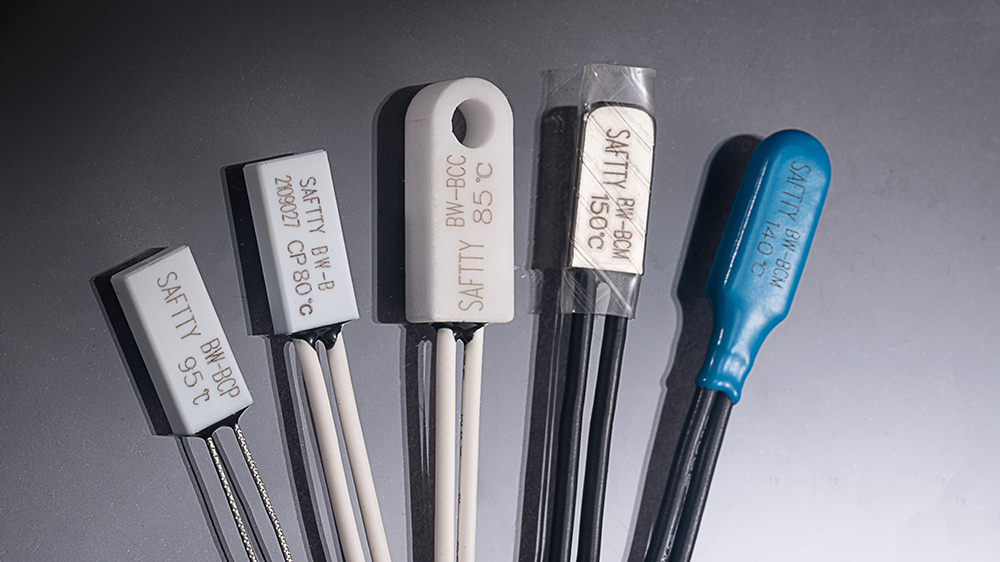In electrical and electronic systems, overheating is one of the most common causes of component failure, equipment malfunction, and even fire hazards. To prevent such incidents, engineers integrate thermal protection devices into designs. Among the most widely used are thermal protectors and thermal fuses.
While both devices serve the same ultimate purpose—protecting equipment from damage due to excessive heat—they differ significantly in structure, operation, functionality, and use cases. Understanding the distinction between thermal protectors and thermal fuses is essential for selecting the right component to ensure safety and reliability.
What Is a Thermal Protector?
A thermal protector is a resettable temperature-sensitive switch designed to open or close an electrical circuit when a certain temperature threshold is reached. Once the temperature returns to a safe level, the protector automatically resets or can be manually reset, depending on the type.
Key Characteristics:
Resettable: Often resets automatically when cooled.
Mechanism: Usually based on a bimetallic strip that bends when heated to open or close a circuit.
Operation: Provides ongoing protection by repeatedly responding to thermal changes.
Response: Triggered by ambient or component temperature.
Common Types:
Normally Closed (NC): Opens when temperature rises beyond a set point.
Normally Open (NO): Closes when heated, used in certain control circuits.
Manual Reset: Requires user intervention to reset after tripping.
What Is a Thermal Fuse?
A thermal fuse, also known as a thermal cutoff, is a non-resettable, single-use device designed to permanently open a circuit when the surrounding temperature exceeds a rated limit. It operates by melting an internal material (often a pellet or alloy), breaking the circuit permanently.
Key Characteristics:
Non-resettable: Once it trips, it must be replaced.
Mechanism: Uses a thermal pellet or fusible alloy that melts at a precise temperature.
Operation: Functions once and protects primarily against over-temperature conditions, not overcurrent.
Response: Extremely accurate with fixed temperature ratings.
Side-by-Side Comparison: Thermal Protector vs. Thermal Fuse
Feature | Thermal Protector | Thermal Fuse |
Reset Capability | Resettable (auto or manual) | One-time use only |
Mechanism | Bimetallic strip, thermal sensor | Melting alloy or pellet |
Function | Interrupts circuit based on heat; reusable | Permanently interrupts circuit due to heat |
Temperature Accuracy | Moderate to high | Very high (±2–5°C tolerance) |
Speed of Response | Slower (mechanical) | Faster (thermal reaction) |
Use Case | Repeated thermal cycling | Emergency cutoff, fire protection |
Typical Applications | Motors, fans, transformers, appliances | Hairdryers, coffee makers, battery packs |
Cost | Higher upfront, reusable | Lower cost, must replace when blown |
Applications of Thermal Protectors
Thermal protectors are used in devices where temperature may regularly rise and fall during operation and where automatic reset is desirable to minimize downtime.
Common Applications:
Electric Motors
Thermal protectors are embedded in windings to shut off the motor if overheating occurs due to overload, locked rotor, or poor ventilation.
Transformers and Ballasts
Protect against thermal stress caused by overloads or environmental conditions.
HVAC Equipment
Fans and compressors use thermal protectors to avoid burnouts from extended operation or ambient heat.
Home Appliances
Washing machines, refrigerators, and vacuum cleaners benefit from the resettable protection to resume operation automatically.
Industrial Machinery
Thermal protectors guard against temperature fluctuations in automated equipment without needing component replacement.
Applications of Thermal Fuses
Thermal fuses are ideal for single-event temperature failures, especially where safety and fire prevention are the top priorities and automatic reset is not acceptable.
Common Applications:
Hairdryers and Irons
To prevent fires if thermostats fail or air vents are blocked.
Microwave Ovens and Coffee Makers
As a backup in case the primary thermostat fails to cut off heat.
Battery Packs (e.g., lithium-ion)
Prevent thermal runaway by severing the power line at critical temperatures.
Lighting Fixtures and Ballasts
To stop operation if overheating occurs due to prolonged use or poor ventilation.
Electric Heating Blankets
Essential for safety in continuous low-power heating products.
Which Should You Choose?
Choosing between a thermal protector and a thermal fuse depends on your application’s requirements:
Choose a Thermal Protector if:
The device naturally heats up and cools down as part of regular operation.
You want a reusable and automatic reset mechanism.
The risk of repeated overheating is present (e.g., motors).
Minimizing downtime is critical.
Choose a Thermal Fuse if:
You need one-time, permanent protection from critical overheating.
The application is safety-sensitive and must not restart automatically.
You’re protecting against catastrophic failure (e.g., fire hazard).
Simplicity and low cost are important.
Complementary Use
In many modern systems, thermal protectors and thermal fuses are used together for layered safety. For example:
A thermal protector handles routine thermal events.
A thermal fuse provides backup protection if the protector fails or the temperature exceeds safe limits.
This redundancy enhances reliability and meets stringent safety standards in critical applications like medical devices, HVAC systems, and consumer electronics.
Thermal protectors and thermal fuses are both essential components in temperature-sensitive circuits, but they serve different roles. Thermal protectors are reusable, resettable, and ideal for dynamic thermal conditions. Thermal fuses offer accurate, permanent disconnection in case of excessive heat and are ideal for fail-safe shutdowns.
Understanding their differences and applications allows designers and technicians to build safer, more reliable systems that prevent damage, reduce risk, and improve operational longevity. For optimal protection, consider using both in tandem, especially in environments where heat buildup could result in serious consequences.













 中文
中文 English
English Deutsch
Deutsch Italiano
Italiano 한국어
한국어 にほんご
にほんご


